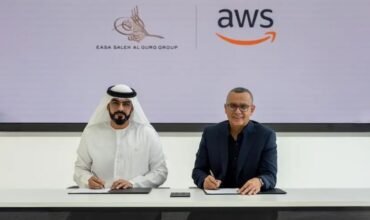At AWS re:Invent, Amazon Web Services (AWS) has announced it will be water positive (water+) by 2030, returning more water to communities than it uses in its direct operations. The company also announced its 2021 global water use efficiency (WUE) metric of 0.25 liters of water per kilowatt-hour, demonstrating AWS’s leadership in water efficiency among cloud providers.
“Water scarcity is a major issue around the world and with today’s water positive announcement we are committing to do our part to help solve this rapidly growing challenge,” said Adam Selipsky, CEO of AWS. “In just a few years half of the world’s population is projected to live in water-stressed areas, so to ensure all people have access to water, we all need to innovate new ways to help conserve and reuse this precious resource. While we are proud of the progress we have made, we know there is more we can do. We are committed to leading on water stewardship in our cloud operations, and returning more water than we use in the communities where we operate. We know this is the right thing to do for the environment and our customers.”
AWS has been driving four key strategies in pursuit of becoming water+ by 2030: improving water efficiency, using sustainable water sources, returning water for community reuse, and supporting water replenishment projects.
Water efficiency: AWS is constantly innovating across its infrastructure to reduce water consumption. It achieves its industry-leading water efficiency by using advanced cloud services, such as Internet of Things (IoT) technologies, to analyze real-time water use and identify and fix leaks. AWS further improves operational efficiency by eliminating cooling water use in many of its facilities for most of the year, instead relying on outside air. For example, in Ireland and Sweden, AWS uses no water to cool its data centers for 95% of the year. AWS also invests in on-site water-treatment systems that allow it to reuse water multiple times, minimizing water consumed for cooling.
Sustainable sources: AWS uses sustainable water sources, such as recycled water and rainwater harvesting, wherever possible. Using recycled water, which is only suitable for a limited set of applications such as irrigation and industrial use, preserves valuable drinking water for communities. In Northern Virginia, AWS worked with Loudoun Water to become the first data center operator in the state approved to use recycled water in direct evaporative cooling systems. AWS already uses recycled water for cooling in 20 data centers around the world and has plans to expand recycled water use in more facilities as it works toward becoming water+.
Community water reuse: After maximizing the use of water in its data centers, the spent liquid is still safe for many other uses, and AWS is finding more ways to return it to communities. In Oregon, AWS provides up to 96% of the cooling water from its data centers to local farmers at no charge for use in irrigating crops like corn, soybeans, and wheat.
Water replenishment: To meet its water+ commitment, AWS is investing in water replenishment projects in the communities where it operates. Replenishment projects expand water access, availability, and quality by restoring watersheds and bringing clean water, sanitation, and hygiene services to water-stressed communities. To date, AWS has completed replenishment projects in Brazil, India, Indonesia, and South Africa, providing 1.6 billion liters of freshwater each year to people in those communities. Building on its existing portfolio of water replenishment programs, AWS has announced several new projects, which, once completed, will provide more than 823 million liters of water to communities.



